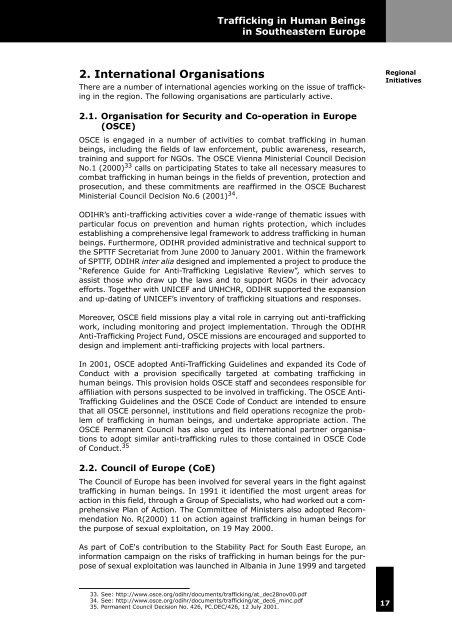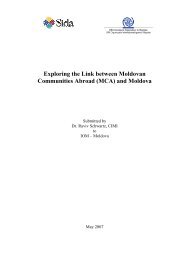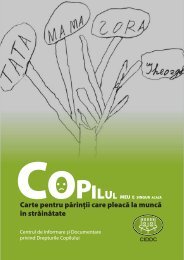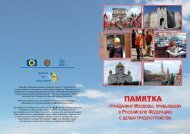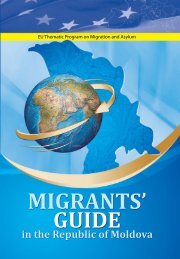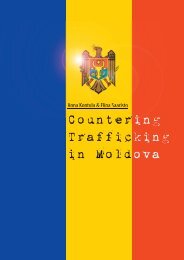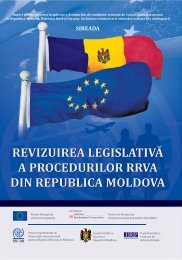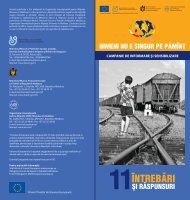Trafficking in Human Beings in Southeastern Europe - Iom
Trafficking in Human Beings in Southeastern Europe - Iom
Trafficking in Human Beings in Southeastern Europe - Iom
- No tags were found...
You also want an ePaper? Increase the reach of your titles
YUMPU automatically turns print PDFs into web optimized ePapers that Google loves.
<strong>Traffick<strong>in</strong>g</strong> <strong>in</strong> <strong>Human</strong> Be<strong>in</strong>gs<strong>in</strong> <strong>Southeastern</strong> <strong>Europe</strong>2. International OrganisationsThere are a number of <strong>in</strong>ternational agencies work<strong>in</strong>g on the issue of traffick<strong>in</strong>g<strong>in</strong> the region. The follow<strong>in</strong>g organisations are particularly active.RegionalInitiatives2.1. Organisation for Security and Co-operation <strong>in</strong> <strong>Europe</strong>(OSCE)OSCE is engaged <strong>in</strong> a number of activities to combat traffick<strong>in</strong>g <strong>in</strong> humanbe<strong>in</strong>gs, <strong>in</strong>clud<strong>in</strong>g the fields of law enforcement, public awareness, research,tra<strong>in</strong><strong>in</strong>g and support for NGOs. The OSCE Vienna M<strong>in</strong>isterial Council DecisionNo.1 (2000) 33 calls on participat<strong>in</strong>g States to take all necessary measures tocombat traffick<strong>in</strong>g <strong>in</strong> human be<strong>in</strong>gs <strong>in</strong> the fields of prevention, protection andprosecution, and these commitments are reaffirmed <strong>in</strong> the OSCE BucharestM<strong>in</strong>isterial Council Decision No.6 (2001) 34 .ODIHR’s anti-traffick<strong>in</strong>g activities cover a wide-range of thematic issues withparticular focus on prevention and human rights protection, which <strong>in</strong>cludesestablish<strong>in</strong>g a comprehensive legal framework to address traffick<strong>in</strong>g <strong>in</strong> humanbe<strong>in</strong>gs. Furthermore, ODIHR provided adm<strong>in</strong>istrative and technical support tothe SPTTF Secretariat from June 2000 to January 2001. With<strong>in</strong> the frameworkof SPTTF, ODIHR <strong>in</strong>ter alia designed and implemented a project to produce the“Reference Guide for Anti-<strong>Traffick<strong>in</strong>g</strong> Legislative Review”, which serves toassist those who draw up the laws and to support NGOs <strong>in</strong> their advocacyefforts. Together with UNICEF and UNHCHR, ODIHR supported the expansionand up-dat<strong>in</strong>g of UNICEF’s <strong>in</strong>ventory of traffick<strong>in</strong>g situations and responses.Moreover, OSCE field missions play a vital role <strong>in</strong> carry<strong>in</strong>g out anti-traffick<strong>in</strong>gwork, <strong>in</strong>clud<strong>in</strong>g monitor<strong>in</strong>g and project implementation. Through the ODIHRAnti-<strong>Traffick<strong>in</strong>g</strong> Project Fund, OSCE missions are encouraged and supported todesign and implement anti-traffick<strong>in</strong>g projects with local partners.In 2001, OSCE adopted Anti-<strong>Traffick<strong>in</strong>g</strong> Guidel<strong>in</strong>es and expanded its Code ofConduct with a provision specifically targeted at combat<strong>in</strong>g traffick<strong>in</strong>g <strong>in</strong>human be<strong>in</strong>gs. This provision holds OSCE staff and secondees responsible foraffiliation with persons suspected to be <strong>in</strong>volved <strong>in</strong> traffick<strong>in</strong>g. The OSCE Anti-<strong>Traffick<strong>in</strong>g</strong> Guidel<strong>in</strong>es and the OSCE Code of Conduct are <strong>in</strong>tended to ensurethat all OSCE personnel, <strong>in</strong>stitutions and field operations recognize the problemof traffick<strong>in</strong>g <strong>in</strong> human be<strong>in</strong>gs, and undertake appropriate action. TheOSCE Permanent Council has also urged its <strong>in</strong>ternational partner organisationsto adopt similar anti-traffick<strong>in</strong>g rules to those conta<strong>in</strong>ed <strong>in</strong> OSCE Codeof Conduct. 352.2. Council of <strong>Europe</strong> (CoE)The Council of <strong>Europe</strong> has been <strong>in</strong>volved for several years <strong>in</strong> the fight aga<strong>in</strong>sttraffick<strong>in</strong>g <strong>in</strong> human be<strong>in</strong>gs. In 1991 it identified the most urgent areas foraction <strong>in</strong> this field, through a Group of Specialists, who had worked out a comprehensivePlan of Action. The Committee of M<strong>in</strong>isters also adopted RecommendationNo. R(2000) 11 on action aga<strong>in</strong>st traffick<strong>in</strong>g <strong>in</strong> human be<strong>in</strong>gs forthe purpose of sexual exploitation, on 19 May 2000.As part of CoE's contribution to the Stability Pact for South East <strong>Europe</strong>, an<strong>in</strong>formation campaign on the risks of traffick<strong>in</strong>g <strong>in</strong> human be<strong>in</strong>gs for the purposeof sexual exploitation was launched <strong>in</strong> Albania <strong>in</strong> June 1999 and targeted33. See: http://www.osce.org/odihr/documents/traffick<strong>in</strong>g/at_dec28nov00.pdf34. See: http://www.osce.org/odihr/documents/traffick<strong>in</strong>g/at_dec6_m<strong>in</strong>c.pdf35. Permanent Council Decision No. 426, PC.DEC/426, 12 July 2001.17


